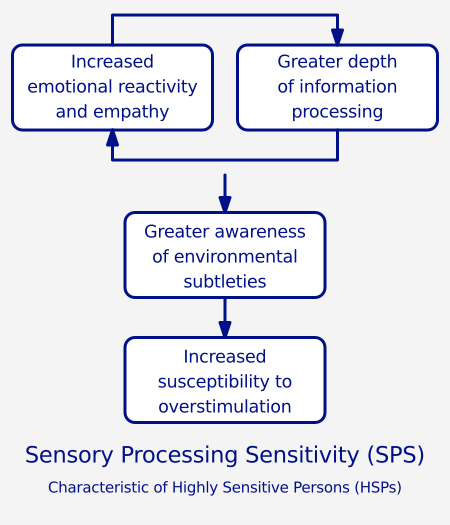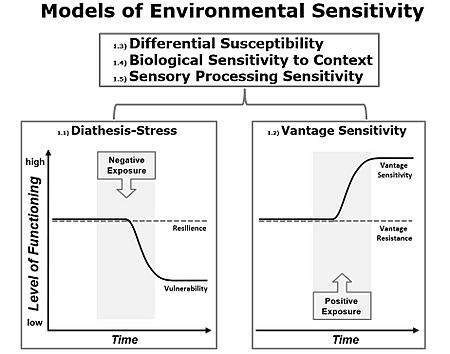Sensory processing sensitivity facts for kids
Sensory processing sensitivity (SPS) is a natural part of someone's personality. It means their central nervous system is more sensitive. They also think more deeply about things they experience. This includes physical feelings, social situations, and emotions.
People with SPS tend to "pause to check" new situations. They notice small details more easily. They also use deeper thinking to figure out how to act. This is often because they feel emotions more strongly, both good and bad.
If someone has a very high level of SPS, they are called a highly sensitive person (HSP). The terms SPS and HSP were created in the mid-1990s. They were developed by psychologists Elaine Aron and her husband Arthur Aron. They also created a questionnaire called the Highly Sensitive Person Scale (HSPS) to measure SPS. Other scientists use different names for this trait.
According to the Arons, about 15–20% of people have high SPS. Some studies have linked high SPS to challenges. However, other studies show it can lead to stronger reactions to both good and bad things. The Arons say that being an HSP is not a problem or a disorder. It's just a normal part of who someone is.
Contents
How the Terms Started
Elaine Aron's book The Highly Sensitive Person came out in 1996. In 1997, Elaine and Arthur Aron officially named sensory processing sensitivity (SPS). They said it was the main trait of highly sensitive persons (HSPs). Common words like hypersensitivity or highly sensitive mean the same thing as SPS.
The Arons explained that "sensory processing" isn't just about your eyes or ears. It's about how your brain handles the information it gets from your senses. They believe this trait is not a disorder. Instead, it's a natural way to survive that has both good and bad sides.
Elaine Aron has written many articles and self-help books. She helps people understand that high SPS is different from being shy. She also helps people with high SPS feel better about themselves. She highlights the good things about being highly sensitive.
In 2015, a journalist wrote in The Wall Street Journal that HSPs were becoming well-known. Many studies had been done on high sensitivity. The first big science conference on high sensitivity was held in Brussels. By 2015, over a million copies of The Highly Sensitive Person had been sold.
Early Ideas About Sensitivity
Before the Arons, other researchers studied sensitivity. In the 1970s, German professor Wolfgang Klages said that sensitivity is "biologically anchored." He believed that sensitive people have a lower "stimulus threshold" in their thalamus. This means more signals go "unfiltered" to the cerebral cortex.
The Arons also looked at psychologist Albert Mehrabian's ideas from the 1970s and 80s. Mehrabian talked about filtering out "irrelevant" information. The Arons noted that if HSPs (who Mehrabian called "low screeners") can't filter well, it means "relevant" is decided by non-HSPs.
What It's Like to Be Highly Sensitive
Boterberg and others (2016) describe high SPS as a personality trait. It means some people have a more sensitive central nervous system. They also process physical, social, and emotional information more deeply.
People with high SPS often report stronger reactions to things. This includes pain, caffeine, hunger, and loud noises. They can easily feel overwhelmed by outside things. This is because they notice more details and think about them deeply. This deeper thinking might make them take more time to react. It can also make them more careful and less likely to take risks.
The HSP Scale was first made to measure SPS. Later, it was broken down into smaller parts. Some parts of high SPS have been linked to challenges. These include high stress, feeling easily overwhelmed, and more anxiety or depression. Some studies also link it to sleep problems and autistic traits. The diathesis–stress model focused on being more likely to be affected by negative things.
However, other ideas suggest that HSPs are more flexible. The differential susceptibility theory and biological sensitivity to context theory say HSPs react more strongly to both good and bad influences. The vantage sensitivity idea focuses on reacting more strongly to positive experiences. Researchers like Smolewska and others (2006) found that positive outcomes were more common in people with high aesthetic sensitivity. These individuals often feel more positive emotions from good experiences. They also tend to be more "open" in their personality.
Scientists studying evolutionary biology have found SPS in over 100 animal species. Aron says that the SPS trait includes what other psychologists have called by different names. Aron also explains what SPS is not. She says it's different from shyness, sensation-seeking, sensory processing disorder, and autism. She believes SPS might be a basic trait that affects many other personality differences. For example, HSPs can be both introverts and extroverts. They can also be both sensation-seeking and cautious at the same time.
In humans and animals, some individuals are more responsive than others. These different levels of responsiveness have pros and cons for survival. This supports Aron's idea that high SPS is not a disorder. It's a personality trait with its own advantages and disadvantages.
By 2015, scientists had studied SPS in many ways. This included looking at personality, behavior, brain function, and genetics. For example, genetic studies show that higher SPS levels are linked to certain genes. These include genes related to serotonin, dopamine, and norepinephrine.
A study in 2015 looked at Swedish men's army medical records. It found a link between a low resting heart rate and violence. The authors thought that lower sensitivity to things might make people more likely to take risks. This is like the opposite of SPS.
The scores on the HSP Scale were thought to fall into two groups. Aron chose the top 20% of scores to define the HSP group. However, a 2019 study suggested that people fall into three sensitivity groups. These groups are spread out along a normal range of sensitivity.
See also
 In Spanish: Sensibilidad de procesamiento sensorial para niños
In Spanish: Sensibilidad de procesamiento sensorial para niños
- Arousal
- Autism
- Differential susceptibility hypothesis
- Environmental sensitivity
- Evolutionary psychology
- Neuropsychology
- Neuroticism
- Personality psychology
- Sensory processing
- Social psychology
- Trait theory
- Cognition
- Executive functions
- Development of the nervous system
- Cultural neuroscience
- Neurodiversity



